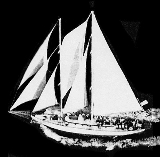
Diosa del Mar
Encyclopedia
The Diosa del Mar was a wooden schooner
that sank off of the coast of Catalina Island
at 2:25 pm on July 30, 1990.
. It was originally christened Uncas
after the famous chief of the Mohegan
tribe. Through various owners, the name was subsequently changed to Wal Gar, Bonnie Doone, and finally Diosa del Mar. In Lloyd's Register of American Yachts it appears as Bonnie Doone until finally disappearing from the registry in 1959 under the ownership of a Dr. Irving E. Laby in Los Angeles, California
.
The yacht was originally built as a staysail
craft for the children of the wealthy Vanderbilt clan
. As originally built she weighed 30 tons, was 66 in 6 in (20.27 m) long, had a total sail area of 3321 square feet (308.5 m²), and a draft of 6 in 7 in (2.01 m). The Diosa was perfectly capable of deep ocean travel. Following the installation in 1916 of a Sterling gas engine, the vessel's capabilities were quite advanced. By 1925 she sported a full keel (modified from her original keel with auxiliary centerboard) and a GM Diesel engine.
According to Lloyd's, the Diosa was burned and rebuilt in 1927. By 1951 she had been refitted with a 6-cylinder Chrysler engine and was operating out of Balboa, California.
In 1979 she won the Serena Cup as the fastest schooner in the Newport to Ensenada
Race (California to Mexico). Subsequently, she sailed from Los Angeles to Hilo, Hawaii
where she operated as a charter until 1982 Under the ownership of Roy Eugene "Gene" Deshler and Margo Deshler along with their two children Karen Smith and Stephen A. Smith. After returning to Los Angeles, she placed second place in the Newport to Ensenada race of 1983. For most of the rest of her life she operated as a charter out of Long Beach, California.
The yacht's demise came about near the end of the 10th annual Firemen's Race in 1990 off the coast of southern California. A small powerboat failed to spot the racing Diosa. The powerboat hove out of the Isthmus of Catalina, cutting in front of the doomed ship. Rather than risk injury or death to the driver and passengers on the smaller craft, Diosas owner and captain Eddie Weinberg steered hard to starboard crashing his ship against Ship Rock The wreckage of the schooner was a favorite of divers for many years before finally breaking up beneath the waters of the Pacific Ocean
.
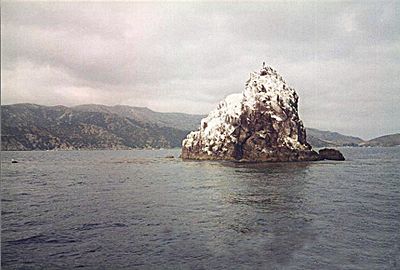 The salvaged stern and mast from the Diosa Del Mar was on display at the Isthmus
The salvaged stern and mast from the Diosa Del Mar was on display at the Isthmus
on Catalina Island
, California
for a number of years.
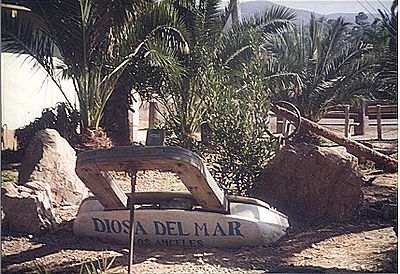
Diosa del Mar is located at 33.462770°N 118.491925°W.
Ship Rock is located 3 miles east of the Isthmus
on Catalina Island
, California
.
Numerous people over the years, since the sinking of the Diosa Del Mar in 1990 had attempted to raise and salvage the keel of the boat. It took two attempts by the Huseman brothers, and about 17 trips to Catalina to move masts and debris in preparation to raise the keel off the rocks and reef, and towed to Long Beach Harbor, California
. The eventual successful salvaging operation in 1993 was "the talk" of the maritime groups and the news media in the Los Angeles Basin, since there had been so many failed attempts over the years.
The Huseman brother's first trip to Catalina Island
was to survey the keel wreckage and the placement in the rocks and reef at Ship Rock. They also discovered that the size of the keel was not as large as they had originally estimated. At first, they thought the keel would weigh about 100,000 lbs (50 tons), but after examining the keel during a dive, and making the calculations it turned out to be only about 40,000 pounds (20 tons). The salvage of the 20-ton keel was for the scrap lead value.
On the first attempt to raise the keel, Gordon Frappier towed a 30 feet (9.1 m) by 8 feet (2.4 m) empty gas tank from the California mainland over to the wreck site next to Ship Rock, three miles from the Isthmus
on Catalina Island
. The reason the tank was used for lifting vs individual lift bags, was the tank was easier to control, and the least expensive means instead of using a multitude of lift bags for the 20-ton keel. After extensive preparations, the tank fitted with chains was floated and positioned over the keel. The tank was filled with water and submerged, then connected to the big turnbuckles and the bronze bolts sticking out of the top of the keel. The divers performed this connection at low tide, then waited for high tide to float the keel and the tank off the rocks, at about 12 ft (3.7 m). When the tide came in, the surge was very strong, and the 20-ton keel and tank swayed back and forth. The bronze nuts on the keel didn't like to bend, and the 1.25 inches (3.2 cm) keel studs broke off and the tank floated to the surface, thus ending their attempt.
The second time they attempted to raise the keel, the same tank was used and the tide was not used for leverage. Ed Huseman positioned the tank over the keel and flooded the tank with water to submerge the tank, and then attached the tank to the keel. The next process was to blow out the water in the tank with the attached keel, and then the two would float to the surface. Ed Huseman figured out that hooking ten air tanks together, containing 72 cubic feet (2 m³) of air and attaching a garden hose from the air tanks to the tank's top valve, the air at the top would force the water out through the bottom of the tank. Ed Huseman's ingenious idea worked very well. The air blew the water out of a 30 feet (9.1 m) x 8 feet (2.4 m) tank in about 30 minutes. The keel and the tank floated up to about 4 feet (1.2 m) off the reef, however there were rocks about 5 ft (1.5 m) that blocked the exit movement of the keel. They tried to pull the tank and keel out one way, but the towboat, a Cal 39 sail boat with a Perkins 4108 50-hp diesel engine, skippered by Dan Cohen, was too far away to tell Cohen that the keel was still stuck in the rocks, and the tow rope snapped into two pieces.
After being in the water for over nine hours that day, the four divers almost gave up. One of the divers, Steve Stiener, said they could move the keel, and they were able to push the tank with just flipper power. The divers all felt that the tank and keel were going to hit more rocks, however the keel and tank moved out of the rock and reef area, went through a bed of seaweed and into dark deep water, and floated to the water's surface. After the broken tow rope was repaired, Cohen started towing the tank and keel out of the rock and the reef area. The exhausted diving crew, after being in the water for two days, and the sailboats left Catalina Island
elated, having achieved a successful salvage operation that no one else had been able to accomplish. The tank and 20-ton keel were then towed 24 miles by the Cal 39 Perkins 4108 50-hp diesel engine across the Catalina Channel to Long Beach Harbor.
Schooner
A schooner is a type of sailing vessel characterized by the use of fore-and-aft sails on two or more masts with the forward mast being no taller than the rear masts....
that sank off of the coast of Catalina Island
Santa Catalina Island, California
Santa Catalina Island, often called Catalina Island, or just Catalina, is a rocky island off the coast of the U.S. state of California. The island is long and across at its greatest width. The island is located about south-southwest of Los Angeles, California. The highest point on the island is...
at 2:25 pm on July 30, 1990.
Overview
The two masted wooden schooner was designed by A. Cary Smith and built in 1898 by the firm of A.C. Brown and Sons of Tottenville, NYStaten Island
Staten Island is a borough of New York City, New York, United States, located in the southwest part of the city. Staten Island is separated from New Jersey by the Arthur Kill and the Kill Van Kull, and from the rest of New York by New York Bay...
. It was originally christened Uncas
Uncas
Uncas was a sachem of the Mohegan who through his alliance with the English colonists in New England against other Indian tribes made the Mohegan the leading regional Indian tribe in lower Connecticut.-Early life and family:...
after the famous chief of the Mohegan
Mohegan
The Mohegan tribe is an Algonquian-speaking tribe that lives in the eastern upper Thames River valley of Connecticut. Mohegan translates to "People of the Wolf". At the time of European contact, the Mohegan and Pequot were one people, historically living in the lower Connecticut region...
tribe. Through various owners, the name was subsequently changed to Wal Gar, Bonnie Doone, and finally Diosa del Mar. In Lloyd's Register of American Yachts it appears as Bonnie Doone until finally disappearing from the registry in 1959 under the ownership of a Dr. Irving E. Laby in Los Angeles, California
Los Angeles, California
Los Angeles , with a population at the 2010 United States Census of 3,792,621, is the most populous city in California, USA and the second most populous in the United States, after New York City. It has an area of , and is located in Southern California...
.
The yacht was originally built as a staysail
Staysail
A staysail is a fore-and-aft rigged sail whose luff can be affixed to a stay running forward from a mast to the deck, the bowsprit or to another mast....
craft for the children of the wealthy Vanderbilt clan
Vanderbilt family
The Vanderbilt family is an American family of Dutch origin prominent during the Gilded Age. It started off with the shipping and railroad empires of Cornelius Vanderbilt, and expanded into various other areas of industry and philanthropy...
. As originally built she weighed 30 tons, was 66 in 6 in (20.27 m) long, had a total sail area of 3321 square feet (308.5 m²), and a draft of 6 in 7 in (2.01 m). The Diosa was perfectly capable of deep ocean travel. Following the installation in 1916 of a Sterling gas engine, the vessel's capabilities were quite advanced. By 1925 she sported a full keel (modified from her original keel with auxiliary centerboard) and a GM Diesel engine.
According to Lloyd's, the Diosa was burned and rebuilt in 1927. By 1951 she had been refitted with a 6-cylinder Chrysler engine and was operating out of Balboa, California.
In 1979 she won the Serena Cup as the fastest schooner in the Newport to Ensenada
Ensenada, Baja California
Ensenada is a coastal city in Mexico and the third-largest city in Baja California. It is located south of San Diego on the Baja California Peninsula. The city is locally referred to as La Cenicienta del Pacífico, or, The Cinderella of the Pacific...
Race (California to Mexico). Subsequently, she sailed from Los Angeles to Hilo, Hawaii
Hawaii
Hawaii is the newest of the 50 U.S. states , and is the only U.S. state made up entirely of islands. It is the northernmost island group in Polynesia, occupying most of an archipelago in the central Pacific Ocean, southwest of the continental United States, southeast of Japan, and northeast of...
where she operated as a charter until 1982 Under the ownership of Roy Eugene "Gene" Deshler and Margo Deshler along with their two children Karen Smith and Stephen A. Smith. After returning to Los Angeles, she placed second place in the Newport to Ensenada race of 1983. For most of the rest of her life she operated as a charter out of Long Beach, California.
The yacht's demise came about near the end of the 10th annual Firemen's Race in 1990 off the coast of southern California. A small powerboat failed to spot the racing Diosa. The powerboat hove out of the Isthmus of Catalina, cutting in front of the doomed ship. Rather than risk injury or death to the driver and passengers on the smaller craft, Diosas owner and captain Eddie Weinberg steered hard to starboard crashing his ship against Ship Rock The wreckage of the schooner was a favorite of divers for many years before finally breaking up beneath the waters of the Pacific Ocean
Pacific Ocean
The Pacific Ocean is the largest of the Earth's oceanic divisions. It extends from the Arctic in the north to the Southern Ocean in the south, bounded by Asia and Australia in the west, and the Americas in the east.At 165.2 million square kilometres in area, this largest division of the World...
.

Isthmus
An isthmus is a narrow strip of land connecting two larger land areas usually with waterforms on either side.Canals are often built through isthmuses where they may be particularly advantageous to create a shortcut for marine transportation...
on Catalina Island
Santa Catalina Island, California
Santa Catalina Island, often called Catalina Island, or just Catalina, is a rocky island off the coast of the U.S. state of California. The island is long and across at its greatest width. The island is located about south-southwest of Los Angeles, California. The highest point on the island is...
, California
California
California is a state located on the West Coast of the United States. It is by far the most populous U.S. state, and the third-largest by land area...
for a number of years.

Spot Where the Diosa del Mar Sank (Ship Rock)
The salvage of the keel was done by Don and Ed Huseman.Diosa del Mar is located at 33.462770°N 118.491925°W.
Ship Rock is located 3 miles east of the Isthmus
Isthmus
An isthmus is a narrow strip of land connecting two larger land areas usually with waterforms on either side.Canals are often built through isthmuses where they may be particularly advantageous to create a shortcut for marine transportation...
on Catalina Island
Santa Catalina Island, California
Santa Catalina Island, often called Catalina Island, or just Catalina, is a rocky island off the coast of the U.S. state of California. The island is long and across at its greatest width. The island is located about south-southwest of Los Angeles, California. The highest point on the island is...
, California
California
California is a state located on the West Coast of the United States. It is by far the most populous U.S. state, and the third-largest by land area...
.
Numerous people over the years, since the sinking of the Diosa Del Mar in 1990 had attempted to raise and salvage the keel of the boat. It took two attempts by the Huseman brothers, and about 17 trips to Catalina to move masts and debris in preparation to raise the keel off the rocks and reef, and towed to Long Beach Harbor, California
California
California is a state located on the West Coast of the United States. It is by far the most populous U.S. state, and the third-largest by land area...
. The eventual successful salvaging operation in 1993 was "the talk" of the maritime groups and the news media in the Los Angeles Basin, since there had been so many failed attempts over the years.
The Huseman brother's first trip to Catalina Island
Santa Catalina Island, California
Santa Catalina Island, often called Catalina Island, or just Catalina, is a rocky island off the coast of the U.S. state of California. The island is long and across at its greatest width. The island is located about south-southwest of Los Angeles, California. The highest point on the island is...
was to survey the keel wreckage and the placement in the rocks and reef at Ship Rock. They also discovered that the size of the keel was not as large as they had originally estimated. At first, they thought the keel would weigh about 100,000 lbs (50 tons), but after examining the keel during a dive, and making the calculations it turned out to be only about 40,000 pounds (20 tons). The salvage of the 20-ton keel was for the scrap lead value.
On the first attempt to raise the keel, Gordon Frappier towed a 30 feet (9.1 m) by 8 feet (2.4 m) empty gas tank from the California mainland over to the wreck site next to Ship Rock, three miles from the Isthmus
Isthmus
An isthmus is a narrow strip of land connecting two larger land areas usually with waterforms on either side.Canals are often built through isthmuses where they may be particularly advantageous to create a shortcut for marine transportation...
on Catalina Island
Santa Catalina Island, California
Santa Catalina Island, often called Catalina Island, or just Catalina, is a rocky island off the coast of the U.S. state of California. The island is long and across at its greatest width. The island is located about south-southwest of Los Angeles, California. The highest point on the island is...
. The reason the tank was used for lifting vs individual lift bags, was the tank was easier to control, and the least expensive means instead of using a multitude of lift bags for the 20-ton keel. After extensive preparations, the tank fitted with chains was floated and positioned over the keel. The tank was filled with water and submerged, then connected to the big turnbuckles and the bronze bolts sticking out of the top of the keel. The divers performed this connection at low tide, then waited for high tide to float the keel and the tank off the rocks, at about 12 ft (3.7 m). When the tide came in, the surge was very strong, and the 20-ton keel and tank swayed back and forth. The bronze nuts on the keel didn't like to bend, and the 1.25 inches (3.2 cm) keel studs broke off and the tank floated to the surface, thus ending their attempt.
The second time they attempted to raise the keel, the same tank was used and the tide was not used for leverage. Ed Huseman positioned the tank over the keel and flooded the tank with water to submerge the tank, and then attached the tank to the keel. The next process was to blow out the water in the tank with the attached keel, and then the two would float to the surface. Ed Huseman figured out that hooking ten air tanks together, containing 72 cubic feet (2 m³) of air and attaching a garden hose from the air tanks to the tank's top valve, the air at the top would force the water out through the bottom of the tank. Ed Huseman's ingenious idea worked very well. The air blew the water out of a 30 feet (9.1 m) x 8 feet (2.4 m) tank in about 30 minutes. The keel and the tank floated up to about 4 feet (1.2 m) off the reef, however there were rocks about 5 ft (1.5 m) that blocked the exit movement of the keel. They tried to pull the tank and keel out one way, but the towboat, a Cal 39 sail boat with a Perkins 4108 50-hp diesel engine, skippered by Dan Cohen, was too far away to tell Cohen that the keel was still stuck in the rocks, and the tow rope snapped into two pieces.
After being in the water for over nine hours that day, the four divers almost gave up. One of the divers, Steve Stiener, said they could move the keel, and they were able to push the tank with just flipper power. The divers all felt that the tank and keel were going to hit more rocks, however the keel and tank moved out of the rock and reef area, went through a bed of seaweed and into dark deep water, and floated to the water's surface. After the broken tow rope was repaired, Cohen started towing the tank and keel out of the rock and the reef area. The exhausted diving crew, after being in the water for two days, and the sailboats left Catalina Island
Santa Catalina Island, California
Santa Catalina Island, often called Catalina Island, or just Catalina, is a rocky island off the coast of the U.S. state of California. The island is long and across at its greatest width. The island is located about south-southwest of Los Angeles, California. The highest point on the island is...
elated, having achieved a successful salvage operation that no one else had been able to accomplish. The tank and 20-ton keel were then towed 24 miles by the Cal 39 Perkins 4108 50-hp diesel engine across the Catalina Channel to Long Beach Harbor.
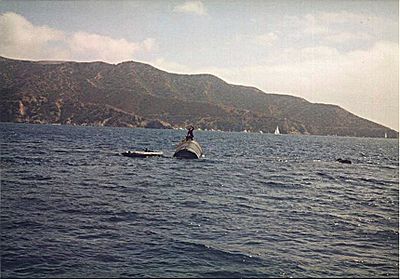 |
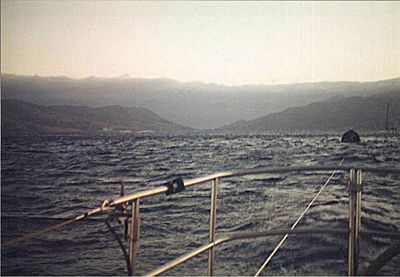 |
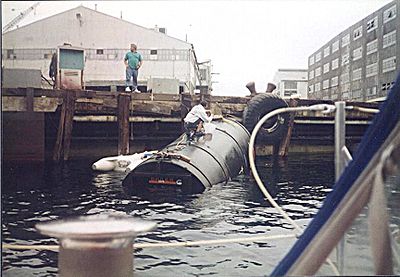 |
Sources
- Lloyd's Register of American Yachts (still listed in 1917 as Uncas; from 1925 through 1959 as Bonnie Doone)
- Diosa del Mar at California Wreck Divers (some incorrect spellings) (retrieved April 14, 2008)
- "Shipwrecks off the coast of California" by Gregory J. Robb (retrieved May 24, 2007)
- Color photos - by Susan Macafee

